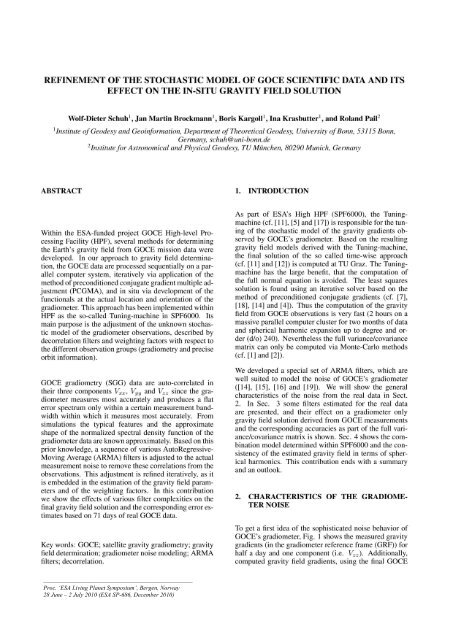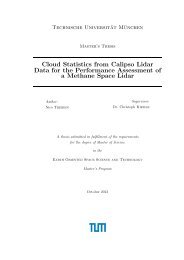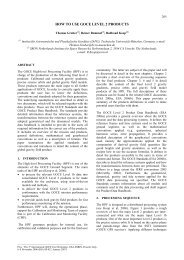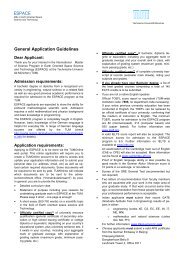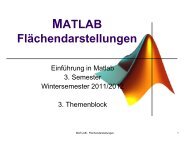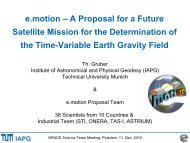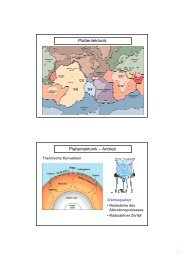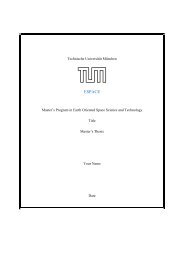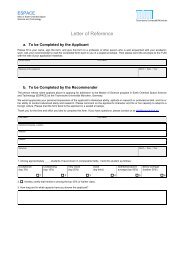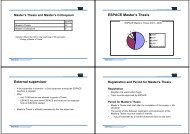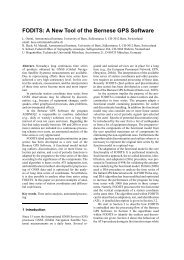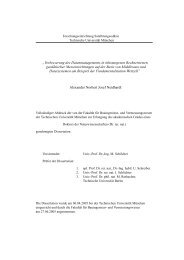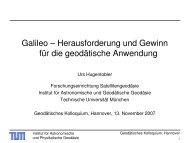Proc. 'ESA Living Planet Symposium', Bergen, Norway 28 June – 2 ...
Proc. 'ESA Living Planet Symposium', Bergen, Norway 28 June – 2 ...
Proc. 'ESA Living Planet Symposium', Bergen, Norway 28 June – 2 ...
You also want an ePaper? Increase the reach of your titles
YUMPU automatically turns print PDFs into web optimized ePapers that Google loves.
_________________________________________________<br />
<strong>Proc</strong>. ‘ESA <strong>Living</strong> <strong>Planet</strong> Symposium’, <strong>Bergen</strong>, <strong>Norway</strong><br />
<strong>28</strong> <strong>June</strong> <strong>–</strong> 2 July 2010 (ESA SP-686, December 2010)
Vzz(E)<br />
3000<br />
2500<br />
2000<br />
1500<br />
1000<br />
500<br />
0<br />
measured<br />
computed<br />
measured-computed<br />
-500<br />
00:00:00 02:00:00 04:00:00 06:00:00 08:00:00 10:00:00 11:59:59 14:00:00<br />
time on 01-Nov-2009<br />
Figure 1. Measured gravity field gradients of GOCE for<br />
a half day and computed gravity field gradients from a<br />
gravity field model and the difference as a first estimation<br />
for the gradiometer noise<br />
Vzz(E)<br />
1.5<br />
1<br />
0.5<br />
0<br />
-0.5<br />
measured - GRS80 (mean reduced)<br />
computed - GRS80 (mean reduced)<br />
measured-computed (mean reduced)<br />
-1<br />
00:00:00 01:00:00 02:00:00<br />
time on 01-Nov-2009<br />
03:00:00 04:00:00<br />
Figure 2. Reduced (mean and GRS80) measured gravity<br />
field gradients of GOCE for 3 hours and computed<br />
gravity field gradients from a gravity field model and the<br />
difference as a first estimation for the gradiometer noise<br />
gravity field model (GO CONS EGM TIM 2I, cf. [12]),<br />
are shown as timeseries. The differences of both timeseries,<br />
measured gradients minus computed gradients, are<br />
an estimation for the gradiometer noise 1 . The timeseries<br />
shown in Fig. 1 is dominated by the large bias in the measured<br />
gradients. Thus, in the displayed scale, the noise<br />
looks only like a bias. Removing the GRS80 signal from<br />
the measured and computed gradients and a mean value<br />
from the observations gives a better impression of the detailed<br />
structure of the measurement noise (cf. Fig. 2).<br />
The resulting (i.e. mean reduced) noise estimation shows<br />
now an additional drift 2 and some long wavelength oscillations,<br />
indicating the strong autocorrelations. The resulting<br />
noise is definitely non-white.<br />
1 Note that the three diagonal components Vxx, Vyy and Vzz show<br />
very similar behavior, but only the Vzz component is shown here.<br />
2 The drift is hard to recognize in this short timeseries of about 3<br />
hours.<br />
Figure 3. Mean reduced noise estimation of the gradiometer<br />
for the Vzz component in the spatial domain.<br />
It is dominated by a one per revolution error<br />
Error [mE/sqrt(Hz)]<br />
10 4<br />
10 3<br />
10 2<br />
10 1<br />
10 0<br />
10 −4<br />
10 −3<br />
PSD<br />
10 −2<br />
Frequency [Hz]<br />
GOCE noise PSD V zz<br />
Gradient signal PSD V zz<br />
GOCE measurement PSD V zz<br />
Figure 4. Error spectrum of the gradiometer noise for<br />
the Vzz component, the gradient signal and the measured<br />
gravity gradients<br />
To get an idea of the spatial behavior, Fig. 3 shows the<br />
mean-reduced gradiometer noise in the GRF for ascending<br />
and descending tracks. It is dominated by a one per<br />
revolution oscillating error. These characteristics can be<br />
shown in the spectral domain of the timeseries very well.<br />
The power spectral density (i.e. the Fourier transform of<br />
the autocorrelation function) from the noise timeseries,<br />
the Earth’s gravity gradient signal (computed from a set<br />
of spherical harmonics of a final GOCE solution) and the<br />
measurements themselves for the Vzz can be seen in Fig.<br />
4 3 .<br />
Analyzing Fig. 4, several characteristics of the estimated<br />
gradiometer noise can be observed. Within the socalled<br />
measurement bandwidth (MBW, between 0.005<br />
and 0.1 Hz), the error spectrum is more or less flat, in<br />
this bandwidth the noise is nearly white. Ranging from<br />
0 to 0.005Hz the error spectrum is mainly characterized<br />
by an inverse proportional dependence (approx. 1/f) and<br />
a large number of sharp peaks. This reflects exactly the<br />
expected behavior, which could be seen in different case<br />
studies before launch of the satellite (e.g. [16]).<br />
3 Note that all other components (Vxx and Vyy) have similar characteristics,<br />
but the level of the noise differs in the MBW (i.e. ≈<br />
8mE/ √ Hz for Vxx, 7mE/ √ Hz for Vyy and 12mE/ √ Hz for<br />
Vzz).<br />
10 −1
When estimating the gravity field parameters via a rigorous<br />
least-squares adjustment, this correlation pattern<br />
would normally have to be taken into account by including<br />
the known (or an estimated approximation of the)<br />
data covariance matrix (as a metric) into the normal equations.<br />
However, due to the huge number of SGG data, this<br />
covariance matrix cannot be stored considering a memory<br />
requirement of more than 20 PetaByte. An effective<br />
solution to this problem consists in a full decorrelation<br />
(”whitening process”) of the SGG data before the evaluation<br />
of the normal equations 4 . Such a decorrelation can<br />
be performed effectively through an application of digital<br />
filters to the SGG observations and the corresponding<br />
observation equations (cf. [13], [14], [19] and [9]).<br />
3. MODELING THE GRADIOMETER NOISE<br />
After describing the main characteristics of the gradiometer<br />
noise in the previous section, we will focus on the<br />
modeling of the noise in the following subsections. As<br />
the full variance/covariance matrix of the gradiometer<br />
observations is even to large to be stored on supercomputers,<br />
the idea of describing the noise characteristics<br />
by an ARMA process was developed in [13]. The inverse<br />
process, which can be seen as a digital filter, can be<br />
used to decorrelate the observations and corresponding<br />
functional model. The transformed observation equations<br />
have white noise and are uncorrelated (e.g. [8], p. 154f.),<br />
such that the least squares adjustment in the gravity field<br />
determination can be performed with a covariance matrix<br />
equaling the identity matrix.<br />
To get a better understanding of the coherence between<br />
digital filters and variance/covariance matrices, in [14] it<br />
is shown how a digital ARMA filter can be transformed<br />
to a variance/covariance matrix. To interpret the following<br />
figures of the noise and the estimated decorrelation<br />
filters in the spectral domain, remind that a filtering in<br />
the time domain is an element by element multiplication<br />
in the spectral domain. Thus, we need to find a filter with<br />
a spectral behavior inverse to the spectral noise behavior<br />
seen in Fig. 4. If we are able to find such a filter, the multiplication<br />
in the spectral domain would follow a curve<br />
constantly equaling 1.0, which is the PSD of white noise.<br />
Thus, we try to estimate a filter, which inverse PSD approximates<br />
the estimated PSD of the noise (cf. Fig. 4)<br />
as good as possible, under the additional condition that it<br />
can be described by as less as possible coefficients. Methods<br />
to estimate such filters of different complexity as cascades<br />
of ARMA filters are explained in detail in e.g. [14]<br />
and [19]. Within this contribution, we will not focus on<br />
the technical side, but show the influence of filters modeling<br />
the noise with different complexities.<br />
4 This means a complete decorrelation, as e.g. described in [8], p.<br />
154f. of the observations and the functional model.<br />
Error [mE/sqrt(Hz)]<br />
10 4<br />
10 3<br />
10 2<br />
10 1<br />
10 0<br />
10 −4<br />
10 −1<br />
10 −3<br />
zz<br />
10 −2<br />
Frequency [Hz]<br />
GOCE noise PSD<br />
filter 9295<br />
Figure 6. Noise PSD ans PSD for the inverse filter 9295<br />
(MBW band-pass filter). The figure is only shown for th<br />
Vzz component. The other diagonal components have all<br />
very similar characteristics.<br />
3.1. Concentrating on the measurement bandwidth<br />
A first idea could be, to apply a filter, which focuses on<br />
the MBW, where the noise spectrum is flat and thus already<br />
close to white noise. Thus, a band-pass filter could<br />
be used to filter the signal and the functional model to the<br />
measurement bandwidth. An estimated (inverse) bandpass<br />
filter can be seen in Fig. 6, designed for the gradiometer’s<br />
MBW, indicated by the black dashed lines.<br />
Applying this filter to the observation equations of the<br />
gradiometer measurements in the gravity field determination<br />
from gradiometer only observations, all information<br />
below the MBW is omitted (long wavelength noise<br />
but also parts of the signal). Thus, the high quality data<br />
within the MBW are processed, but the information outside<br />
the MBW is ignored in the estimation process.<br />
Gravity field determination with such a kind of filter is<br />
possible <strong>–</strong> but has some disadvantages, as shown in the<br />
following. A gradiometer only gravity field solution computed<br />
with this filter is shown in terms coefficient differences<br />
to the 7 years based GRACE only model ITG-<br />
Grace2010s (cf. [10]) to the maximal resolution of the<br />
GRACE field which is d/o 180. Fig. 5(a) shows that<br />
the coefficient errors (i.e. coefficient differences to the<br />
GRACE model) to d/o 50 are very large. Note that to d/o<br />
120 the GRACE model can be seen as a kind of reference<br />
solution, as GRACE is more sensitive to the lower<br />
degrees then the GOCE solution. The error per degree<br />
decreases from d/o 50 to d/o 100 but is still very large to<br />
d/o 100 for the sectorial coefficients 5 .<br />
These quality characteristics of the sectorial and near sectorial<br />
coefficients are reflected by the estimated spherical<br />
harmonic coefficient accuracies shown in Fig. 5(b). The<br />
standard deviations show, that the sectorial coefficients to<br />
degree 100 are bad determined as indicated in the coefficient<br />
differences to the ITG-Grace2010s model. The co-<br />
5 It should be mentioned in this context that intentionally a very moderate<br />
band-pass filter was chosen, where the noise reduction in the stopband<br />
is only in the magnitude of 60 dB this avoids a singularity of the<br />
SGG gravity field solution.<br />
10 −1
degree<br />
0<br />
60<br />
120<br />
180<br />
180<br />
120<br />
sin<br />
60<br />
0 60 120 180<br />
cos<br />
−8<br />
−9<br />
−10<br />
−11<br />
−12<br />
(a) Coefficient differences of SGG only solution computed with the filter<br />
9295 compared to ITG-Grace2010s.<br />
degree<br />
0<br />
60<br />
120<br />
180<br />
180<br />
120<br />
sin<br />
60<br />
0 60 120 180<br />
(c) Coefficient differences of a SGG only solution computed with the filter<br />
1000 compared to ITG-Grace2010s.<br />
degree<br />
0<br />
60<br />
120<br />
180<br />
180<br />
120<br />
sin<br />
60<br />
cos<br />
0 60 120 180<br />
(e) Coefficient differences of a SGG only solution computed with the filter<br />
9024 compared to ITG-Grace2010s.<br />
degree<br />
0<br />
60<br />
120<br />
180<br />
180<br />
120<br />
sin<br />
60<br />
cos<br />
0 60 120 180<br />
(g) Coefficient differences of a SGG only solution computed with the filter<br />
9025 compared to ITG-Grace2010s.<br />
cos<br />
−8<br />
−9<br />
−10<br />
−11<br />
−12<br />
−8<br />
−9<br />
−10<br />
−11<br />
−12<br />
−8<br />
−9<br />
−10<br />
−11<br />
−12<br />
log 10<br />
log 10<br />
log 10<br />
log 10<br />
degree<br />
0<br />
60<br />
120<br />
180<br />
180<br />
120<br />
sin<br />
60<br />
0 60 120 180<br />
(b) Estimated formal coefficient accuracies of SGG only solution computed<br />
with the filter 9295.<br />
degree<br />
0<br />
60<br />
120<br />
180<br />
180<br />
120<br />
sin<br />
60<br />
cos<br />
0 60 120 180<br />
(d) Estimated formal coefficient accuracies of a SGG only solution computed<br />
with the filter 1000.<br />
degree<br />
0<br />
60<br />
120<br />
180<br />
180<br />
120<br />
sin<br />
60<br />
cos<br />
0 60 120 180<br />
(f) Estimated formal coefficient accuracies of a SGG only solution computed<br />
with the filter 9024.<br />
degree<br />
0<br />
60<br />
120<br />
180<br />
180<br />
120<br />
sin<br />
60<br />
cos<br />
0 60 120 180<br />
(h) Estimated formal coefficient accuracies of a SGG only solution computed<br />
with the filter 9025.<br />
Figure 5. Coefficient statistics for all four presented SGG solutions with the four different filters. The shown statistics are<br />
difference to the ITG-Grace2010s model (left column), estimated formal coefficient standard deviations (right column).<br />
cos<br />
−8<br />
−9<br />
−10<br />
−11<br />
−12<br />
−8<br />
−9<br />
−10<br />
−11<br />
−12<br />
−8<br />
−9<br />
−10<br />
−11<br />
−12<br />
−8<br />
−9<br />
−10<br />
−11<br />
−12<br />
log 10<br />
log 10<br />
log 10<br />
log 10
Error [mE/sqrt(Hz)]<br />
10 4<br />
10 3<br />
10 2<br />
10 1<br />
10 0<br />
10 −4<br />
10 −1<br />
10 −3<br />
zz<br />
10 −2<br />
Frequency [Hz]<br />
GOCE noise PSD<br />
filter 1000<br />
Figure 7. Noise PSD ans PSD for the inverse filter 1000<br />
(differentiation filter). The figure is only shown for th Vzz<br />
component. The other components have all very similar<br />
characteristics.<br />
efficient differences compared to ITG-Grace2010s in the<br />
lower degrees show an agreement to the estimated variances.<br />
In the degrees 80 to 150, the differences to the<br />
GRACE model are well described by the corresponding<br />
GOCE accuracies. The displayed high degrees are dominated<br />
by the GRACE error, the GOCE variances show<br />
that GOCE performs better starting from degree 150. The<br />
high degrees 180-220, are not shown, as they cannot be<br />
compared to the lower degree GRACE model.<br />
Using a band-pass filter as shown in Fig. 6 produces a<br />
useful gradiometer only gravity field and realistic estimates<br />
for the coefficient variances, but has the disadvantage<br />
that gradiometer information in the lower frequencies<br />
is ignored and that effects the sectorial coefficients to<br />
degree 100 6 . This can be more or less compensated when<br />
combining the gradiometer observation with the GPS observations<br />
from GPS tracking (SST).<br />
3.2. Modeling the long wavelength errors<br />
As the band-pass filter produces systematic errors for<br />
the sectorial coefficients, a further idea of the filter design<br />
would be to model the noise characteristics for the<br />
low frequencies. Thus a filter could be estimated, which<br />
down-weights the lower frequencies but keeps all information<br />
starting from the MBW. This means, we do not filter<br />
out the long wavelengths completely, but model their<br />
the poor quality in the adjustment. A very simple filter<br />
could be a differentiation filter (ID 1000) as shown in<br />
Fig. 7. These filter can be used to decorrelate the observed<br />
gradients and start the gravity field determination<br />
as a spherical harmonic series.<br />
A comparison of a solution using this filter as stochastic<br />
information for the gradients to GRACE is shown in Fig.<br />
5(c). Obviously the lower degree coefficient differences<br />
6 Note that the better the band-pass filter approximates an ideal bandpass<br />
filter the higher the degrees where the sectorial coefficients are<br />
estimated bad. The effect of ill-defined sectorial coefficients would be<br />
intensified with a higher noise reduction in the stop-band.<br />
10 −1<br />
Error [mE/sqrt(Hz)]<br />
10 4<br />
10 3<br />
10 2<br />
10 1<br />
10 0<br />
10 −4<br />
10 −1<br />
10 −3<br />
zz<br />
10 −2<br />
Frequency [Hz]<br />
GOCE noise PSD<br />
filter 9024<br />
Figure 8. Noise PSD ans PSD for the inverse filter 9024.<br />
The figure is only shown for th Vzz component. The other<br />
components have all very similar characteristics<br />
to GRACE (to d/o 80) are smaller than for the band-pass<br />
filter solution. The sectorial coefficients are determined<br />
well starting from d/o 20. It can be seen clearly in the<br />
variances, that the information outside the MBW contains<br />
information especially for the sectorial coefficients. The<br />
estimated accuracies in Fig. 5(d) show the better stability<br />
of the sectorial coefficients. The quality of the solution<br />
gets better, but the estimated accuracies have a wrong<br />
shape for the higher degrees (d/o 120+). The formal errors<br />
for the low orders of higher degrees are estimated too<br />
optimistic. This results from the incomplete modeling of<br />
the filter of the MBW frequencies. The filter introduces<br />
a weighting in the MBW which is not correct. Using the<br />
information of the whole spectrum seems to be a good<br />
idea, but a kind of mixture between the band-pass filter<br />
model and this filter model needs to be found to combine<br />
the advantages of both models.<br />
3.3. Simple modeling of the complete spectrum<br />
Combining simple filters to a consecutive filter series (so<br />
call filter cascades) allow for the design of more complex<br />
filters. A filter should be designed which approximates<br />
the complete noise spectrum and not only parts of it, as<br />
did by the models before. Thus, in Fig. 8 a filter was<br />
designed modeling long wavelength errors as well as the<br />
MBW as good as possible. The smallest number of filter<br />
coefficients possible was used to keep the model simple.<br />
The filter constitutes two cascades, one modeling the long<br />
wavelength part (similar to filter 1000) and a second one,<br />
an ARMA filter of a higher order modeling the high pass<br />
filtered rest correlations in the context of a least squares<br />
fit. Connecting both filter parts, the PSD plot in Fig. 8<br />
shows the approximation of the noise. This filter with<br />
ID 9024 needs only 50 AR and 50 MA coefficients per<br />
gradiometer component to describe the whole noise behavior.<br />
Additionally it has only a short warmup (2000<br />
positions will be lost as filter initialization). The resulting<br />
gravity field solution combines the advantages of the<br />
band-pass filter solution and the difference filter solution.<br />
The solution is at least as good as the difference<br />
10 −1
Error [mE/sqrt(Hz)]<br />
10 4<br />
10 3<br />
10 2<br />
10 1<br />
10 0<br />
10 −4<br />
10 −1<br />
10 −3<br />
zz<br />
10 −2<br />
Frequency [Hz]<br />
GOCE noise PSD<br />
filter 9025<br />
Figure 9. Noise PSD ans PSD for the inverse filter 1000.<br />
The figure is only shown for th Vzz component. The other<br />
components have all very similar characteristics<br />
filter solution in all degrees (cf, Fig. 5(e)) as it shows<br />
mainly the same difference pattern compared to ITG-<br />
Grace2010s. The benefit of this modeling is visible in<br />
the estimated spherical harmonic coefficient standard deviations.<br />
The higher degree error is modeled very well<br />
by the estimated formal spherical harmonic coefficient errors<br />
(cf. Fig. 5(f)), the shape of the errors shows a good<br />
agreement for the errors compared to GRACE up to degree<br />
150.<br />
3.4. Complex modeling of the complete spectrum<br />
Analyzing the filter with the ID 9024 (cf. Fig. 8), it can<br />
be seen that the n per revolution peaks in the spectrum<br />
are not modeled individually. Instead, this pattern is approximated<br />
simple (it seems to be linear in the double<br />
logarithmic plot). To improve the filter modeling, additional<br />
cascades could be added constituting special Notch<br />
filters (e.g. [19]) eliminating special frequencies from the<br />
signal. Thus, the filter is extended by several new filter<br />
cascades, each eliminating one of the sharp peaks in the<br />
spectrum. This filter (ID 9025) can be seen in Fig. 9.<br />
It consists of 20 cascades with about 100 AR and 100<br />
MA coefficients. The notch filter cascades, realized as<br />
ARMA(2,2) filters, are responsible for a filter warmup of<br />
200000 positions 7 . Computing a gradiometer-only gravity<br />
field solution with this kind of filter, we see no improvement<br />
in the solution (cf. Fig 5(g)) compared to the<br />
former model, but an improvement in the estimated variances<br />
is evident.<br />
Comparing the coefficients estimated with filter 9024 and<br />
9025 to the ITG-Grace2010s model coefficients, larger<br />
errors can be seen in the lower degree coefficients with<br />
the orders 16, 32, 48, 64. These are ill-defined coefficients<br />
due to the n per revolution error. Modeling these<br />
error peaks within the complex filter, these bad determined<br />
coefficients are indicated in the estimated coefficient<br />
accuracies (cf. Fig 5(h)). Thus, modeling the filter<br />
as complex as possible, we map the error structure<br />
7 This means, using this filter in the gravity field determination,<br />
200000 observations are thrown away during the filter initialization.<br />
10 −1<br />
(b) Highpass filter<br />
(a) unfiltered SGG errors (c) Highpass filtered errors<br />
(g) fully filtered errors<br />
(f) ARMA filter<br />
(d) Notch filters<br />
(e) Notch filtered errors<br />
Figure 10. Effect of the different filter cascades in the<br />
decorrelation process illustrated in the spectral domain<br />
of the GOCE gradiometer as good as possible to the coefficient<br />
accuracies of the estimated spherical harmonic<br />
expansion. Thus, we achieve a high quality and realistic<br />
formal error variance/covariance matrix. The effect of all<br />
cascades of this complex filter is summarized within Fig.<br />
10.<br />
4. COMBINATION WITH GPS OBSERVATIONS<br />
Within SPF6000 the Tuning-machine is used to estimate<br />
a decorrelation filter for the gradiometer observation for<br />
the gravity field determination using the time wise approach<br />
amongst others. As the first GOCE gravity field<br />
model is only based on 71 days of gradiometer observations,<br />
we decided to use the simple filter 9024 for the final<br />
GO CONS EGM TIM 2I solution. The simple filter<br />
model was preferred in order to keep the filter warmup<br />
short within the first short data period (2000 instead of<br />
200000). But these complex filters will be used in future<br />
gravity field solutions, when the data period is longer and<br />
thus the coverage is better. It was shown above, that the<br />
filters are globally similar, but filter 9024 does not map<br />
the ill-defined orders to the variance/covariance matrix.<br />
At first, this seems to be uncritical, as this ill-defined orders<br />
are mainly in the low degrees, which are determined<br />
mainly by the GPS observations within the final solution.<br />
But, a look into the details shows that inconsistencies between<br />
the data and the covariance modeling stresses the<br />
combined solution. Modeling of the ill-defined orders in<br />
the gradiometer covariances yields to a higher weight of<br />
the GPS observations for this coefficients. This yields to<br />
a better final solution after combining gradiometer and<br />
GPS observations as the relative weights are more realistic.<br />
Fig. 11 shows a combined GOCE solution, a gradiometer<br />
only solution (SGG) and a solution determined by GPS<br />
tracking (SST) using the energy balance approach (e.g.<br />
[3]). Fig. 11 shows an improvement of the combined so-
degree variance<br />
10 0<br />
10 −1<br />
10 −2<br />
10 −3<br />
10 −4<br />
EIGEN5C SST<br />
SGG SST+SGG<br />
0 50 100 150 200<br />
sh degree<br />
Figure 11. Degree variances estimated using coefficient<br />
differences to the EIGEN5C model computed without the<br />
near zonal coefficients to exclude the effect of the polar<br />
gap. Shown is a gradiometer only solution (SGG), a solution<br />
only computed from the GPS tracking (SST) and the<br />
combined one, compared to the Signal of the EIGEN5C.<br />
lution from d/o 20 combining the SST only model with<br />
the SGG observations. This shows, that a long wavelength<br />
error modeling of the gradiometer noise is essential,<br />
if the best solution based on only GOCE observations<br />
should be determined.<br />
Comparing the final GO CONS EGM TIM 2I model to<br />
independently determined gravity field models, the consistence<br />
of the models in terms of degree variances can be<br />
shown clearly. Fig. 12 shows the final SPF6000 solution<br />
compared to the ITG-Grace2010s solution. Especially in<br />
the lower degrees, the 7 year based GRACE model is better<br />
than the GOCE only model based on just 71 days. The<br />
degree variances estimated from coefficient differences<br />
show a very good agreement with the estimated GOCE<br />
model accuracies to d/o 120. Starting from d/o 120 the<br />
GOCE solution becomes more accurate than the GRACE<br />
solution. For the very high degrees 150 - 180, where<br />
GOCE performs better, the GRACE accuracies show a<br />
good agreement to the difference to the GOCE model.<br />
Fig. 13 shows the final GO CONS EGM TIM 2I solution<br />
compared to the EIGEN5C model (c.f. [6]),<br />
which is a high degree combination model, including<br />
e.g. GRACE, altimetry and terrestrial data. For the<br />
low degrees (90) the combined model performs better<br />
than GOCE, due to the included GRACE observations.<br />
The estimated GOCE accuracies show again a consistent<br />
compared to the error estimated from the coefficient<br />
differences. From degree 90 to 190, GOCE improves<br />
the combined model, the accuracies of the combined<br />
EIGEN5C model follow the difference curve, as<br />
the GOCE accuracies are smaller. For the higher degrees<br />
200+, the combined model performs better again, due to<br />
the high frequency sensitive terrestrial data included in<br />
the combination model.<br />
degree variance<br />
10 0<br />
10 −1<br />
10 −2<br />
10 −3<br />
10 −4<br />
ITG GRACE2010S WP6000<br />
0 50 100 150<br />
sh degree<br />
Figure 12. Degree variances estimated using coefficient<br />
differences to the ITG-Grace2010s model computed<br />
without the near zonal coefficients to exclude the effect<br />
of the polar gap. Shown is the combined final<br />
WP6000 (GO CONS EGM TIM 2I) solution compared<br />
to the GRACE only model ITG-Grace2010s. The degree<br />
variances estimated from formal errors are shown as a<br />
dashed line.<br />
degree variance<br />
10 0<br />
10 −1<br />
10 −2<br />
10 −3<br />
10 −4<br />
EIGEN5C WP6000<br />
0 50 100 150 200<br />
sh degree<br />
Figure 13. Degree variances estimated using coefficient<br />
differences to the EIGEN5C model computed<br />
without the near zonal coefficients to exclude the effect<br />
of the polar gap. Shown is the combined final<br />
WP6000 (GO CONS EGM TIM 2I) solution compared<br />
to the model EIGEN5C. The degree variances estimated<br />
from formal errors are shown as a dashed line.<br />
5. SUMMARY AND CONCLUSIONS<br />
The presented tuned decorrelation filters are used within<br />
GOCE HPF SPF6000, determining a GOCE only gravity<br />
field using the so-called time-wise approach. We showed<br />
that we spent a huge numerical effort to determine digital<br />
filters, that can be used to decorrelate the GOCE gradient<br />
observations for the purpose of gravity field determination.<br />
We showed that a modeling of the complete<br />
error spectrum is essential to compute the best possible<br />
gravity field from GOCE observations. In addition, the<br />
full variance/covariance matrix will be distributed with<br />
the final solution (cf. [12]). Compared to independent
models (ITG-Grace2010s and EIGEN5C) the estimated<br />
formal accuracies show a consistent model. The provided<br />
variance/covariance matrix is of a very high quality,<br />
as it is modeled straight forward throughout all computation<br />
steps of GOCE only gravity field determination<br />
steps. As no external information is included in the solution,<br />
the solution and the variance/covariance matrix are<br />
thus self-consistent. We recommend to use the full variance/covariance<br />
matrix in as many applications as possible,<br />
where the GOCE model is used. As can be seen in<br />
comparison to independent models, the provided covariance<br />
matrix reflects the true error characteristics of the<br />
GOCE gravity field solution. With the coefficients and<br />
the full variance/covariance matrix, indirectly the full set<br />
of normal equations are available, which allows for the<br />
use in combination models (e.g. with GRACE, altimetry<br />
or terrestrial data).<br />
ACKNOWLEDGMENTS<br />
Parts of this work were financially supported by the<br />
BMBF Geotechnologien program REAL-GOCE and the<br />
ESA GOCE HPF contract No. 18308/04/NL/MM. The<br />
computations were performed on the JUROPA supercomputer<br />
in Jülich. The computing time was granted by John<br />
von Neumann Institute for Computing (project HBN15).<br />
REFERENCES<br />
[1] H. Alkhatib. On Monte Carlo methods with applications<br />
to the current satellite gravity missions.<br />
PhD thesis, Institute of Geodesy and Geoinformation,<br />
University of Bonn, Bonn, 2007.<br />
[2] H. Alkhatib and W.-D. Schuh. Integration of the<br />
Monte Carlo covariance estimation strategy into<br />
tailored solution procedures for large-scaled least<br />
squares problems. Journal of Geodesy, 70:53<strong>–</strong>66,<br />
2007.<br />
[3] T. Badura. Gravity Field Analysis from Satellite<br />
Orbit Information applying the Energy Integral Approach.<br />
PhD thesis, TU Graz, Graz, 2006.<br />
[4] C. Boxhammer. Effiziente numerische Verfahren<br />
zur sphärischen harmonischen Analyse von Satellitendaten.<br />
PhD thesis, Institute of Geodesy and<br />
Geoinformation, University of Bonn, Bonn, 2006.<br />
[5] J.M. Brockmann, B. Kargoll, I. Krasbutter, W.-<br />
D. Schuh, and M. Wermuth. GOCE data analysis:<br />
From calibrated measurements to the global earth<br />
gravity field. In N.N., editor, Observation of the<br />
Earth System from Space, accepted. Springer, 2009.<br />
[6] C. Foerste, F. Flechtner, R. Schmidt, R. Stubenvoll,<br />
M. Rothacher, J. Kusche, K.-H. Neumayer,<br />
R. Biancale, J.-M. Lemoine, F. Barthelmes, S. Bruinsma,<br />
R. Koenig, and U. Meyer. EIGEN-GL05C<br />
- A new global combined high-resolution GRACEbased<br />
gravity field model of the GFZ-GRGS cooperation.<br />
In Geophysical Research Abstracts,<br />
volume 10 of General Assembly European Geosciences<br />
Union, Vienna, 2008.<br />
[7] M. Hestenes and E. Stiefel. Methods of conjugate<br />
gradients for solving linear systems. Journal of Research<br />
of the National Bureau of Standards, 49 (6),<br />
Research Paper 2379, 1952.<br />
[8] K.R. Koch. Parameter Estimation and Hypothesis<br />
Testing in Linear Models. Springer<br />
Berlin/Heidelberg, 2 edition, 1999.<br />
[9] I. Krasbutter. Dekorrelation und Daten-TÜV der<br />
GOCE-Residuen. Diploma thesis, Universität<br />
Bonn, Bonn, 2009.<br />
[10] T Mayer-Gürr, E. Kurtenbach, and A. Eicker.<br />
ITG-Grace2010s. http://www.igg.unibonn.de/apmg/index.php?id=itg-grace2010,<br />
2010.<br />
[11] R. Pail, B. Metzler, B. Lackner, T. Preimesberger,<br />
E. Hck, W.-D. Schuh, H. Alkathib, C. Boxhammer,<br />
C. Siemes, and M. Wermuth. GOCE gravity field<br />
analysis in the framework of HPF: operational software<br />
system and simulation results. In 3 rd GOCE<br />
user workshop, Frascati, 2006. ESA.<br />
[12] R. Pail, H. Goiginger, R. Mayrhofer, W.-D. Schuh,<br />
J. M. Brockmann, I. Krasbutter, E. Hck, and<br />
T. Fecher. GOCE gracity field model derived from<br />
orbit and gradiometry data applying the time-wise<br />
method. In <strong>Proc</strong>eedings of the ESA <strong>Living</strong> <strong>Planet</strong><br />
Symposium, <strong>Bergen</strong>, <strong>28</strong> <strong>June</strong> 2 July 2010. ESA.<br />
[13] W.D. Schuh. SST/SGG tailored numerical solution<br />
strategies. Technical report, ESA-Project<br />
CIGAR III / Phase 2, WP 221, Final-Report, Part<br />
2, 1995.<br />
[14] W.-D. Schuh. Tailored Numerical Solution Strategies<br />
for the Global Determination of the Earth’s<br />
Gravity Field, volume 81 of Mitteilungen der<br />
geodätischen Institute der Technischen Universität<br />
Graz. TU Graz, Graz, 1996.<br />
[15] W.-D. Schuh. The processing of band-limited measurements;<br />
filtering techniques in the least squares<br />
context and in the presence of data gaps. In G. Beutler,<br />
M.R. Drinkwater, R. Rummel, and R. von<br />
Steiger, editors, Earth Gravity Field from Space -<br />
From Sensors to Earth Sciences, volume 108, pages<br />
67<strong>–</strong>78. Space Science Reviews, 2003. ISSI Workshop,<br />
Bern (March 11-15,2002).<br />
[16] W.-D. Schuh, C. Boxhammer, and C. Siemes. Correlations,<br />
variances, covariances — from GOCE<br />
signals to GOCE products. In 3 rd GOCE user workshop,<br />
Frascati, 2006. ESA.<br />
[17] W.-D. Schuh, J.M. Brockmann, B. Kargoll, and<br />
I. Krasbutter. Adaptive Optimization of GOCE<br />
Gravity Field Modeling. In G. Münster et. al.,<br />
eds, NIC Symposium 2010, IAS Series, 3:313<strong>–</strong>320,<br />
Jülich, 2010.<br />
[18] H.R. Schwarz. Die Methode der konjugierten Gradienten<br />
in der Ausgleichsrechnung. ZfV, 95:130<strong>–</strong><br />
140, 1970.<br />
[19] C. Siemes. Digital Filtering Algorithms for Decorrelation<br />
within Large Least Squares Problems. PhD<br />
thesis, Institute of Geodesy and Geoinformation,<br />
University of Bonn, Bonn, 2008.


